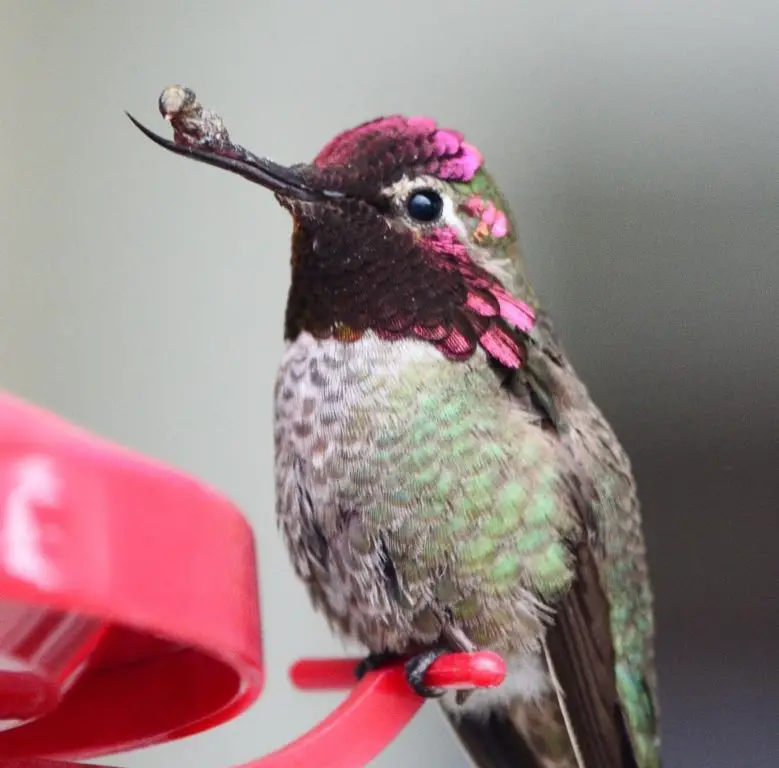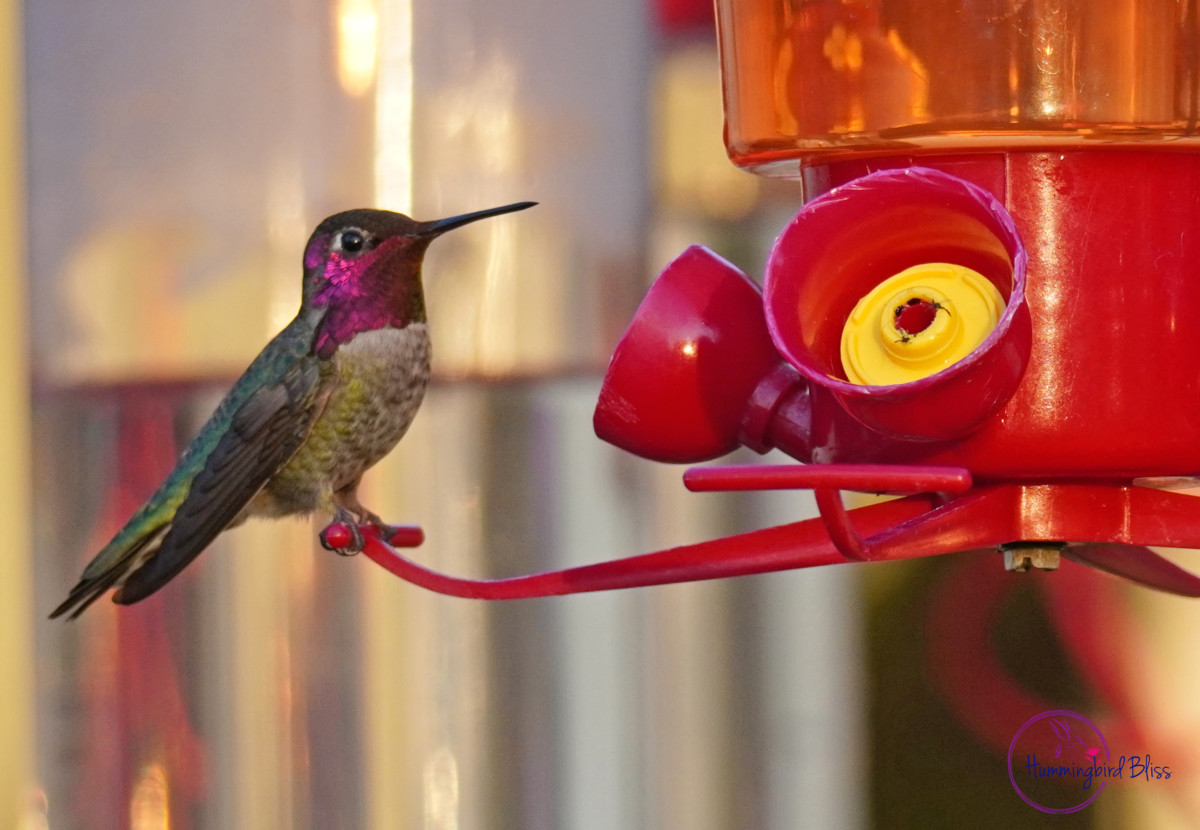This post contains affiliate links.
What is the black stuff on my hummingbird feeder?
The black stuff on a hummingbird feeder is probably mold. There is no mold species called “black mold”. If black mold is seen on a hummingbird feeder it is most likely Candida, a potentially lethal pathogen for hummingbirds causing a prolonged and cruel death.
As the seasons change and the weather gets warmer, hummingbird enthusiasts may encounter black mold build up in the body of their feeders, flower attachments and bee guards. This happens more quickly when the feeder is left in direct full sun exposure.
Observing this frequent occurrence, especially during the hot summers, I realized how problematic this black mold is and wondered what are safe remedies to keep my hummingbird feeders clean.
Hot weather creates the perfect environment for bacteria and black mold growth therefore, properly cleaning your hummingbird feeders that have a wide base is extremely important in order to not transfer diseases or harm your hummingbirds.
Homemade nectar that is too sweet and placed in the sun can result in increasing the fermentation process causing accelerated reproduction of black mold.
Leaving hummingbird feeders unattended in extremely hot weather or in direct sunlight for over a day is a mistake that can easily cause rapid growth of black mold in the hummingbird feeder.
The initial contamination may come from fermentation or an introduction of the mold to the feeder by an already infected hummingbird feeding from the feeder.
As a general rule of thumb, if the hummingbird feeder is in moderate temperatures and placed in the shade, filling the hummingbird feeders with fresh homemade nectar regularly every 3- 5 days, should keep black mold at bay.
See my article: How to Help Hummingbirds in Hot Weather
See my article: Forget Commercial Hummingbird Food Try Making Homemade Nectar
Is black mold harmful to hummingbirds?
Candida, the most common black mold found on hummingbird feeders, will infect a hummingbird’s tongue causing the tongue to swell, over a period of days, to the point of not allowing the hummingbird to consume nectar. The end result is the hummingbird starves to death.
Candida found on hummingbird feeders is the result of nectar fermentation or nectar contamination from an infected hummingbird feeding at that feeder.
Once a hummingbird feeder is infected it will require aggressive cleaning of all components of the hummingbird feeder.
It is important to purchase hummingbird feeders that completely disassembles for cleaning.
How do I get rid of black mold on my hummingbird feeder?
To get rid of black mold on a hummingbird feeder, soak and scrub the feeder by using a diluted solution ratio of 2 parts water to 1 part hydrogen peroxide or white vinegar. Use different size bottle brushes to reach and clean difficult places. Do not use warm soapy water to clean your hummingbird feeders.
Hydrogen peroxide or white vinegar does not leave behind warm soapy residue that can cause harm and is a better alternative for cleaning black mold from your hummingbird feeder.
Black mold and fungus can easily build up in the flower attachments on regular hummingbird feeders as well as from using the standard size yellow bee guards. These guards are added to the flower or opening that is attached to the feeder to prevent bees accessing the nectar. Remove them and clean separately.
Let the hummingbird feeder components soak in the hydrogen peroxide or vinegar solution before scrubbing with a bottle brush for thorough cleaning and optimal results until the black mold is completely removed from the feeder.
Completing these steps will eliminate black mold that builds up in or around the feeder preventing re-contamination. Feeder maintenance is imperative for sustaining healthy ecosystems for hummingbirds.
How do you keep hummingbird nectar from molding?
- Keep hummingbird feeders in the shade.
- Clean your hummingbird feeders frequently.
- Use 1 to 4 sugar to water ratio for homemade nectar.
- Purchase feeders that have a wider mouth and completely disassemble for easy cleaning.
- Provide adequate number of feeders for the number of hummingbirds visiting the feeders.
Keeping hummingbird feeders in the shade prevents the spread of diseases and slows the fermentation process.
Feeder maintenance is imperative for sustaining healthy hummingbirds and their environments. Conditions are easier for bacteria to grow in hot direct sunlight. The increased fermentation process will become obvious and result in showing significant signs of black mold growth on your feeders.
Plastic feeders can cause homemade nectar to ferment more quickly than glass feeders during the warm weather season.
Frequently clean your hummingbird feeders. Feeders in hot weather and direct sunlight may require daily cleaning while feeders in moderate temperatures and placed in the shade may need cleaning only every 3 to 5 days.
This cleaning schedule should eliminate black mold and mildew from infecting in your feeder.
Switch out the homemade hummingbird nectar daily for temperatures exceeding 100 degrees Fahrenheit. Leaving sugar water in a hummingbird feeder out in the heat can cause the homemade nectar to ferment, producing a perfect environment for spreading diseases and creating unwanted problems.
Change your homemade nectar more frequently when using plastic feeders.
Some very good advice is even if there are no signs of black mold, continue to regularly clean your feeders.
Using 1 to 4 sugar to water ratio for homemade nectar will prevent the hummingbird nectar from becoming too sweet or sticky and difficult to digest.
Over-sweetened homemade nectar in direct sunlight acts as a catalysis and ferments the over-sweetened nectar quickly, producing black mold.
This 1 to 4 sugar to water ratio for homemade nectar perfectly mimics the natural composition of nectar in nature.
See my article: Forget Commercial Hummingbird Food Try Making Homemade Nectar
Purchasing feeders that have a wider mouth and completely disassemble for easy cleaning makes it extremely helpful and less time consuming for the user to clean the feeder.
Your hummingbirds will be grateful to be dining at a disease free or mold free establishment from diseases and pathogens.
Having a situation where one of your hummingbird feeders has accumulated too much black mold buildup and is difficult to properly clean, discard the feeder and buy a new one.
Provide adequate number of feeders for the number of hummingbirds visiting the feeders. The best place black mold can easily multiply and spread also occurs at overcrowded feeding stations.
What are the most common things infecting hummingbird feeders?
- The four most common diseases found on hummingbird feeders that are harmful to hummingbirds are:
- Candidiasis (fungal tongue infection)
- Avian poxvirus (tumor growths on beaks)
- Aspergillosis (type of mold/fungus)
- Salmonellosis (bacterial)
Transference of diseases can be linked to improper, infrequently cleaned or overcrowded hummingbird feeders. These toxic environments can ultimately lead to a hummingbird’s death.

Photo by: Kevin Walsh
This male Anna’s hummingbird has a deformed, diseased or damaged beak. He may have been born with a deformity. He may have caught a disease from an unkept hummingbird feeder or damaged his beak while defending his territory.
It is extremely disheartening to see these outcomes. As much as he is a survivor, I wonder if he now is a contributor to spreading pathogens to other hummingbirds at the feeders.
As a hummingbird enthusiast, I want to protect my flying acrobatic friends as much as I can and reduce any more obstacles in their path to safely live a long and healthy life.
See my article: Hummingbird Diseases: From Pathogens to Prevention
Final Thoughts:
Black mold on hummingbird feeders is toxic and harmful to hummingbirds. Black mold spreads more quickly in hot weather in direct sunlight.
Keeping hummingbird feeders in the shade, cleaning feeders frequently with a purchased wider mouth for easier cleaning while using 1 to 4 sugar to water ratio for homemade nectar will aid in reducing black mold build up.
Soak and scrub the feeder by using a bottle brush and a diluted solution of a ratio of 2 parts water to 1 part hydrogen peroxide or white vinegar.
Feeder maintenance is essential for healthy, happy and disease-free hummingbirds!
Happy Hummingbird Watching!

Taken: Camarillo, CA
Backyard Visitors participates in affiliate programs which compensate us for referring traffic.


